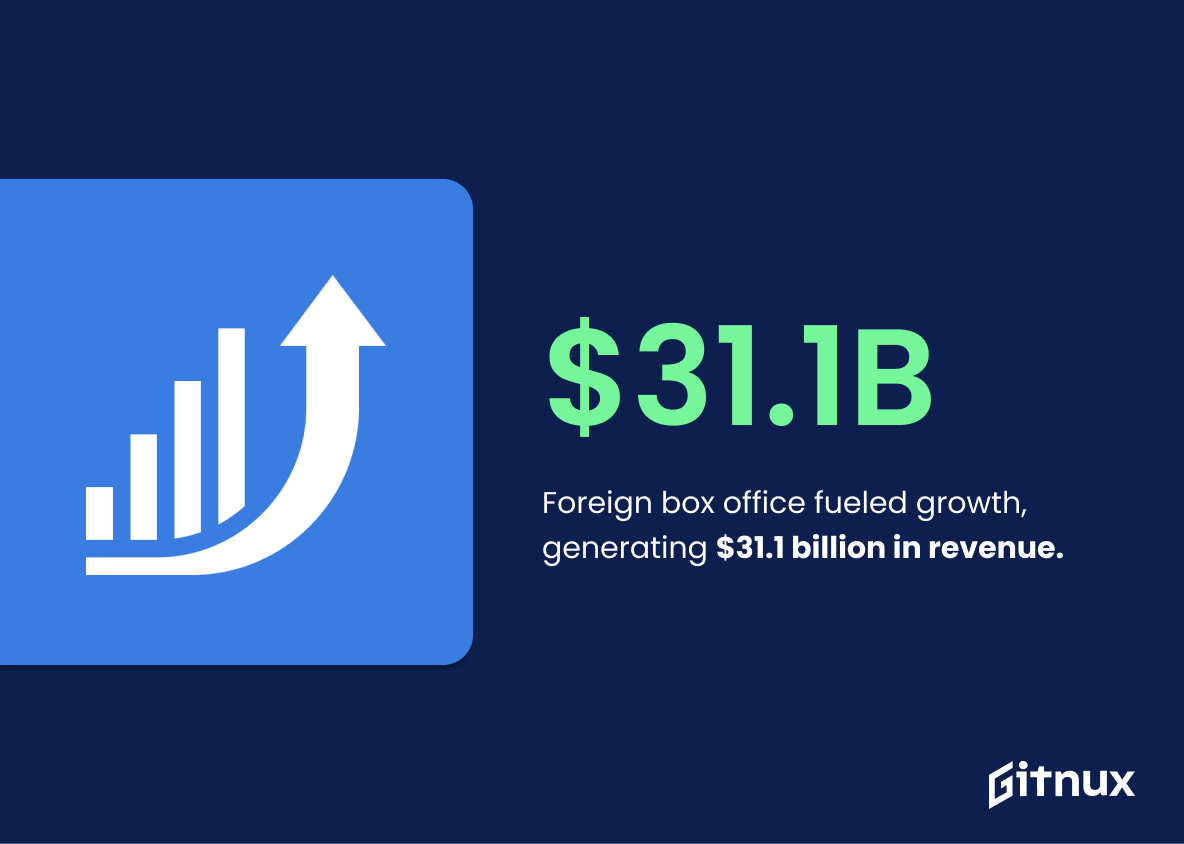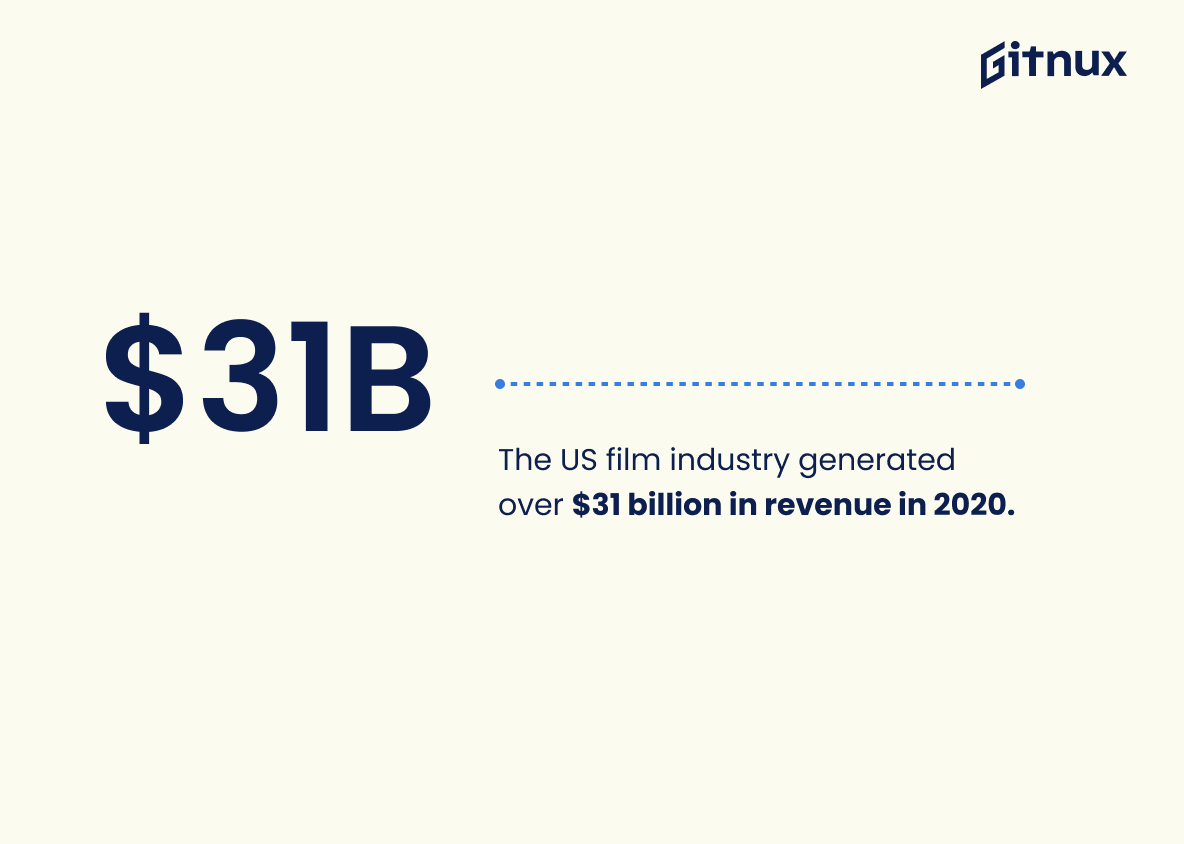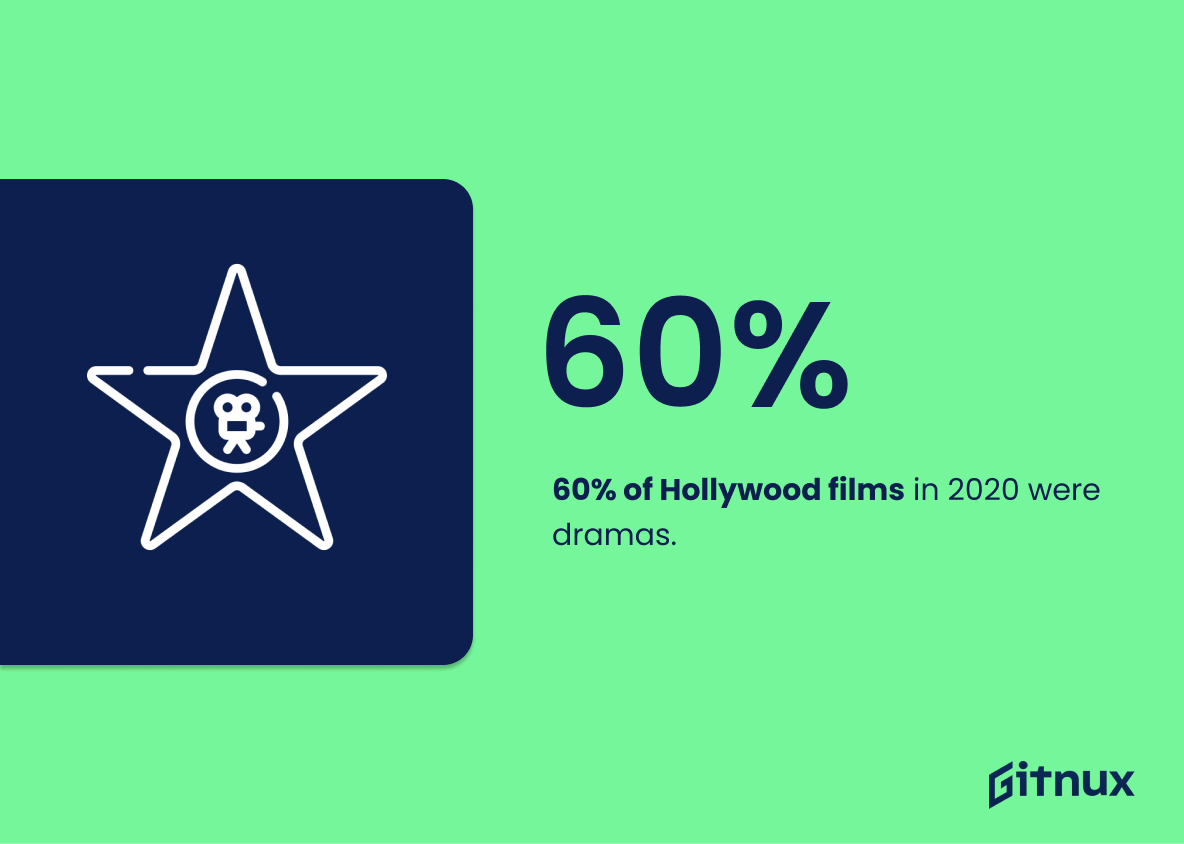The film industry is a major part of the entertainment industry, and its impact is felt around the world. It has been a major source of income for many people and has been the focus of many people’s lives. Film Industry Statistics can provide insight into its success, its challenges, and its future.
This blog post will explore some of the most interesting and important film industry statistics, from box office numbers to the number of people employed in the industry. Learn more about the film industry and its impact on the world by reading this blog post.
Film Industry: The Most Important Statistics
41% of responding internet users said they rarely went to the movies.
Domestic revenue for 2020 stands at around $2.2 billion, down from 2019 by 81.4%.
Film Industry General Statistics
Global Box Office revenue hit a record $42.5 billion in 2019 despite a mixed performance in North America, where ticket sales came in at $11.4 billion, a 4% decline from 2018.
The growth spurt was fueled by the foreign box office, where revenue came in at $31.1 billion.
Worldwide revenue was up 2% from 2018’s $41.7 billion, with foreign markets such as China, Japan, South Korea, France, Germany, Russia, Mexico, Spain, Brazil, and Italy, among others seeing huge gains.
The Global Box Office fell by 72% in a beleaguered 2020 for the film industry, finishing the year with $12 billion in ticket sales, according to the ‘Motion Picture Association’s (MPA) annual THEME report’.
It was the foreign box office that was responsible for $9.8 billion in ticket sales, representing 81% of the overall global market, $6 billion of that coming from the Asia Pacific region.
In a survey carried out in the United States in April and May 2022, approximately 41% of responding internet users said they rarely went to the movies. Roughly one-third stated that they went to see a film in theaters sometimes, while 8% reported doing it often. 18% of interviewees said they never went to the movies.
Film Industry Statistics In The US & Canada
2019 Domestic Box Office reached close to $11.4 billion according to Box Office Mojo, down 4% from the previous year’s banner $11.89 billion.
Mid-December is usually a launching pad for holiday blockbusters, but with Hollywood and theater owners grappling with the Covid-19 crisis it resulted in the worst showing for domestic ticket sales in almost four decades.
Domestic revenue for 2020 stands at around $2.2 billion, down from 2019 by 81.4%.
Film Industry Statistics In The UK
The UK box office recovered from a slow start and had a strong finish.
However, revenue is still falling on a year-on-year basis, which was foreseen to continue to 2020 with fewer surefire hits due for release.
£1.277 billion box office revenue was recorded in 2018, with a 2% decrease of £1.251 billion in 2019.
Box office soared in the first two months of 2020, but when the pandemic hit it couldn’t maintain that momentum.
According to the latest Comscore data, the UK box office reached £323 million in 2020 which meant a 76% drop from 2019.
Film Industry Statistics In China
Even without heavy-hitter Hollywood films doing well in China, the Chinese box office continued to grow.
The box office revenue rose 5.4% to a new record of $9.2 billion in 2019- albeit at a slower growth rate of 9% compared to the previous year.
China was the first major international territory to have its box office wiped out by Covid-19 as cinemas closed on January 23 and hadn’t reopened till July 20th.
However, it was the first to recover thanks to its local releases such as Guan Hu’s war epic “The Eight Hundred”, which opened in August.
It didn’t only top China’s Box Office in 2020, but was also the highest-grossing film globally for the year, with a gross of $451 million.
The total box office for 2020 was down by 68% to $3.12 billion (RMB20.4bn) on 548 million admissions, compared to $9.2 billion (RMB64.3 billion) in 2019, according to figures from China Film Administration.
Film Industry Statistics In Japan
The Motion Picture Producers Association Of Japan announced a 17% year-on-year increase, reaching ¥261 billion in 2019.
This is the highest figure recorded since the recording system was introduced in 2000.
Their movie theatre attendance also broke records in 2019 with 195 million people spending on average ¥1,340 each on tickets.
The Japanese box office plummeted more than 45% in 2020 after the pandemic hit.
Total ticket sales clocked in at around ¥143.3 down from 261 billion yen in 2019 which was an all-time record.
Film Industry Talent Representation Statistics
A study found that women accounted for 43% of those working as directors, writers, producers, executive producers, editors, and cinematographers on documentaries, compared to 34% on narrative features.
It also found that the age of women working in each of those job categories was higher on documentaries than on narrative features.
The data show that films with a Black producer (8% of all US-produced films) or a Black director (6% of all films) are significantly more likely to have a Black writer.
In addition, if a film’s producer is Black, the film is far more likely to have a Black director, too.
Supplementary Statistics
The global film industry revenue is estimated to be $101.22 billion in 2021.
This shows that despite the challenges posed by the pandemic, the industry is still thriving and is expected to reach new heights in 2021. It is a great indication of the potential of the film industry and its ability to generate revenue and create jobs. It is also a reminder of the importance of investing in the film industry and the potential it has to drive economic growth.
In 2021, 8,617 film festivals took place worldwide.
It speaks to the resilience of the film industry and its ability to adapt to changing circumstances. But it also highlights the importance of film festivals as a platform for filmmakers to showcase their work and gain recognition. Finally, it serves as a reminder of the power of cinema to bring people together, even in the most challenging of times.
The US film industry generated over $31 billion in revenue in 2020.
Thus, it serves as a reminder of the power of the film industry to bring joy and entertainment to people all over the world.
China’s box office reached $3.1 billion in 2020.
The fact that China’s box office reached $3.1 billion in 2020 is a testament to the immense potential of the film industry in the country. It is a clear indication that the Chinese film industry is growing at a rapid pace and is becoming an increasingly important player in the global film industry. This statistic is a reminder of the importance of understanding the Chinese film industry and its impact on the global film industry.
India produces the highest number of movies per year, with over 2000 films in 2020.
There is a sheer amount of creativity and hard work that goes into producing such a large number of films each year. It speaks to the immense popularity of Indian films, as evidenced by the fact that they are produced in such large numbers. This statistic is a reminder of the immense potential of the Indian film industry and its ability to captivate audiences around the world.
About 60% of Hollywood films in 2020 were dramas.
It reveals that the majority of films released in 2020 were dramas, suggesting that the industry is heavily invested in this genre. This statistic is important to consider when discussing the trends and developments in the film industry.
The total number of feature films produced in the European Union reached 1,798 in 2020.
Despite the challenges posed by the pandemic, the EU was still able to produce a significant number of feature films in 2020. This is a testament to the resilience of the industry and its ability to adapt to changing circumstances.
In 2021, the average movie ticket price in North America was $9.16.
The average movie ticket price in North America in 2021 serves as a telling indicator of the state of the film industry. It reflects the cost of entertainment for moviegoers, as well as the financial health of the industry as a whole. This statistic can be used to gauge the success of the industry, as well as the impact of any changes in ticket prices on the industry’s bottom line.
The global streaming market was valued at $50.11 billion in 2020.
This highlights the increasing demand for streaming services, and the potential for further growth in the future. It also serves as a reminder of the importance of staying up-to-date with the latest trends in the film industry, as streaming is quickly becoming the preferred way to watch movies and TV shows.
In 2020, the African film industry was valued at $1.2 billion.
The African film industry’s valuation of $1.2 billion in 2020 is a testament to the immense potential of the continent’s creative industry. It is a sign of the growing influence of African films and filmmakers on the global stage, and a reminder of the immense potential of the African film industry. This statistic is a powerful reminder of the importance of investing in the African film industry and the potential for growth and success it holds.
Animation and VFX make up approximately 27.3% of the global film industry market.
This is a reminder of the potential of animation and VFX to create captivating stories and visuals that can draw in audiences and make a lasting impact.
The European film industry gross box office was approximately 6.8 billion euros in 2019.
This highlights the immense popularity of European films and the potential for further growth in the industry. It also serves as a reminder of the importance of the film industry in Europe, both economically and culturally.
The worldwide film industry is projected to grow at 2% CAGR between 2021 and 2028.
With this statistic, filmmakers, producers, and investors can gain a better understanding of the industry’s trajectory and plan accordingly.
Approximately 50% of revenue for Hollywood films comes from international markets.
The film industry is a global phenomenon, and that it is important to consider the international market when discussing the success of Hollywood films.
In 2020, the Oscar-winning film “Parasite” earned around $266.61 million worldwide.
The success of “Parasite” in 2020 serves as a testament to the power of the film industry. Not only did it win an Oscar, but it also earned a staggering $266.61 million worldwide. This remarkable achievement highlights the potential of the film industry to captivate audiences and generate significant revenue.
Online movie ticket sales accounted for 43% of all sales by 2020.
This is indicative of the changing landscape of the film industry, and it is an important reminder of the importance of staying up-to-date with the latest trends.
In 2020, the video game industry was nearly 3 times the size of the global film industry, reaching $180.3 billion in revenue.
The video game industry has become a major player in the entertainment industry, with its revenue nearly tripling that of the film industry. This is a significant development that should not be overlooked when discussing the current state of the film industry.
Female representation in the film industry was 42% in 2020, a 9% increase since 1992.
Despite the challenges that women have faced in the industry, there has been a steady increase in the number of women working in the film industry over the past 28 years. This is an encouraging sign that the industry is becoming more inclusive and that more opportunities are being made available to women.
Conclusion
The film industry has seen a significant increase in viewership over the past few years, with more people watching films than ever before. This is largely due to the increased availability of streaming services, as well as the introduction of new technologies like virtual reality.
With the industry continuing to grow, it is important for filmmakers to stay up-to-date with the latest trends and technologies in order to stay competitive. By understanding the industry’s current trends, filmmakers can create content that resonates with audiences.
References
Hollywood Reporter: “2019 Global Box Office Revenue Hit Record $42.5B Despite 4 Percent Dip in U.S.”, cited in February 2023 (Source)
Deadline: “2020 Worldwide Box Office Slumps 71% To $12.4B Amid Covid Impact: Strength Of International, Piracy Concerns & Hope Dominate 2021 Chatter – Global Studio Rankings Chart”, cited in February 2023 (Source)
Deadline: “Box Office 2019: What Went Right & Wrong In An $11.4 Billion Year & How 2020 Is Shaping Up”, cited in February 2023 (Source)
Hollywood Reporter: “2020 Box Office: Domestic Revenue Falls to 40-Year Low”, cited in February 2023 (Source)
Screen Daily: “UK box office admissions fall slightly in 2019; blockbuster concerns for 2020”, cited in February 2023 (Source)
Screen Daily: “Analysis: UK and Ireland box office fell 76% in 2020”, cited in February 2023 (Source)
Nippon: “Four ¥10 Billion Blockbusters Lift Japan’s Box Office Revenue to Record High in 2019”, cited in February 2023 (Source)
Hollywood Reporter: “Japan’s Box Office Fell 45 Percent to $1.38 Billion in 2020”, cited in February 2023 (Source)
Variety: “China’s Box Office Hit New Heights in 2019, as Hollywood’s Share Shrank”, cited in February 2023 (Source)
Screen Daily: “China box office topped North America in 2020 thanks to quicker post-lockdown recovery, strong local titles”, cited in February 2023 (Source)
Statista: “Frequency of going to see a movie in theaters among adults in the United States as of May 2022”, cited in February 2023 (Source)
Deadline: “Women Much More Likely To Land Top Behind-The-Scenes Jobs On Documentaries Than Narrative Pics, Study Of U.S. Film Festivals Finds”, cited in February 2023 (Source)
Mckinsey: “Black representation in film and TV: The challenges and impact of increasing diversity”, cited in February 2023 (Source)
Box Office Mojo: “Domestic Yearly Box Office”, cited in February 2023 (Source)















